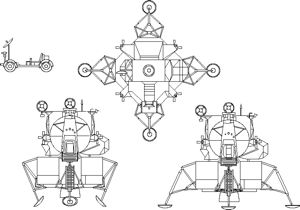
Home - Search - Browse - Alphabetic Index: 0- 1- 2- 3- 4- 5- 6- 7- 8- 9
A- B- C- D- E- F- G- H- I- J- K- L- M- N- O- P- Q- R- S- T- U- V- W- X- Y- Z
FLEM
 Apolo LM Credit: © Mark Wade |
Status: Study 1966. Gross mass: 118,000 kg (260,000 lb).
A Mars expedition concept where the lander would separate from a manned Mars flyby spacecraft, aerobrake directly into the Martian atmosphere, land on the surface, and then place itself into solar orbit, and rendezvous and dock with the flyby spacecraft. Since the main spacecraft would not have to brake into and out of Mars orbit, huge propellant savings were possible, making a manned Mars landing expedition possible in a single Saturn V launch.
FLEM was described in a 30 June 1966 report by R R Titus, an engineer at United Aircraft. This Flyby-Landing Excursion Module could separate from the a manned Mars flyby spacecraft 60 days before reaching the planet, and thrust into a faster trajectory. FLEM would have enough propellant to brake into Mars orbit, select an acceptable landing point, enter the Martian atmosphere, land, and then boost itself to solar orbit. This would allow it to reach Mars and spend 19 days on the surface before it would have to rocket back into solar orbit to rendezvous and dock with the Mars flyby spacecraft. A separation 30 days before the flyby would give it 9 days on the surface. Titus calculated that using FLEM with a nuclear thermal upper stage, the total spacecraft mass for a manned landing expedition could be kept to 118 metric tons, meaning a single Saturn V launch could mount a Mars landing mission. An unmanned version of FLEM was dubbed MSSR and was proposed as a surface-sample return vehicle in the NASA Planetary Joint Action group flyby plan of 1966-1967.
FLEM Mission Summary:
- Summary: Flyby-rendezvous spacecraft design.
- Propulsion: Nuclear thermal
- Braking at Mars: flyby-rendezvous
- Mission Type: Crocco
- Split or All-Up: split
- ISRU: no ISRU
- Launch Year: 1985
- Crew: 3
- Outbound time-days: 130
- Mars Stay Time-days: 19
- Return Time-days: 560
- Total Mission Time-days: 690
- Total Payload Required in Low Earth Orbit-metric tons: 118
- Mass per crew-metric tons: 39
- Launch Vehicle Payload to LEO-metric tons: 118
- Number of Launches Required to Assemble Payload in Low Earth Orbit: 1
- Launch Vehicle: Saturn MLV-V-1
Crew Size: 3.
Family: Mars Expeditions. Country: USA. Propellants: Nuclear/LH2. Agency: United Aircraft. Bibliography: 591.
Back to top of page
Home - Search - Browse - Alphabetic Index: 0- 1- 2- 3- 4- 5- 6- 7- 8- 9
A- B- C- D- E- F- G- H- I- J- K- L- M- N- O- P- Q- R- S- T- U- V- W- X- Y- Z
© 1997-2019 Mark Wade - Contact
© / Conditions for Use